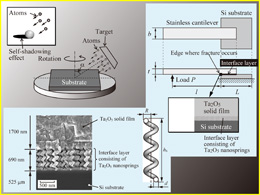EXPERIMENT

Interface fracture mechanics in nanometer scale materials
Singular stress field sometime appears near an interface edge where interface meets surface. In a bulk material, the crack initiation and growth is discussed in terms of the fracture mechanics assuming the continuum media. However, the size of singular stress area in nano-materials is also nano-meter scale which is length of a few tens – a few hundreds atomic diameters. It is questionable whether the conventional fracture mechanics concept is available or not on the scale. We have been investigated by precise experiments and in situ SEM/TEM observations.

Fatigue in nanometer scale materials
In a fatigue, distinctive dislocation structures with micrometer scale appear in metallic bulk materials before the crack initiation. The understructure, however, can not be formed in a nano-material because of the space. Therefore, there is question whether the fatigue damage can form in it or not. If there is fatigue, what is the mechanism? In order to investigate the fatigue behavior of nano-materials, we carry out in situ TEM fatigue and resonant fatigue experiments.

Mechanical behavior of aggregated nanometer scale elements
With the development of process technology, it becomes possible to make thin films comprised of aggregated nanometer scale elements where the shape is well controlled. Although these have characteristic mechanical behavior, it has not been investigated. We inquire the deformation and fracture mechanics/mechanism of the films made by the dynamic oblique deposition method.
SIMULATION

Multi-physics in nanometer scale materials
Nanometer scale materials, which are surrounded by surfaces, often show unique properties of the ferro-electricity and ferro-magnetism. The mechanical stress/strain changes the property, which is called "multi-physics". We have been investigating such mysterious property through numerical simulations on the basis of the first-principles.

Multi-ferroics in nanometer scale materials
The materials, which have both of ferroelectricity and ferromagnetism, are called "multi-ferroics". BiFeO3 is a typical example of such materials. Nanometer scale materials made from multi-ferroics are expected to possess novel behavior due to the effect of the surfaces including the multi-physics behavior (interactions among stress/strain, ferroelectricity and ferromagnetism).
Moreover, we found that magnetism appears in a non-magnetic material PbTiO3 for nanometer scale components with defects. The mysterious property is highly dependent on the nanometer scale structure.

Fracture (strength) of atomic components
In nanometer scale components, the applicability of fundamental fracture mechanics concept becomes questionable because it is based on the continuum mechanics. We have investigated the fracture behavior of low-dimensional nano-components on the basis of electronic/atomic simulations. We also research the instability (including not only mechanical instability but also functional one) as the nucleation of nanometer scale fracture.



 Download
Download